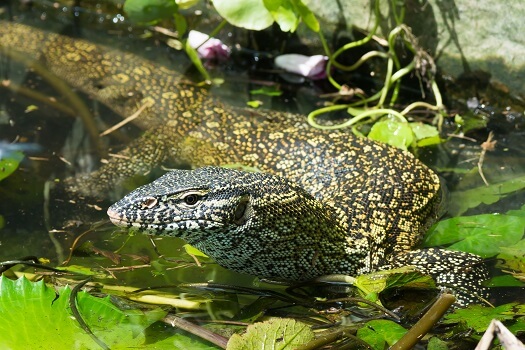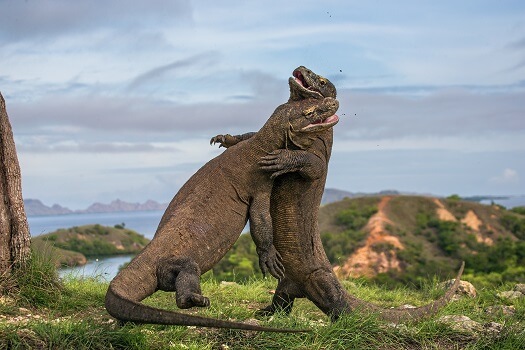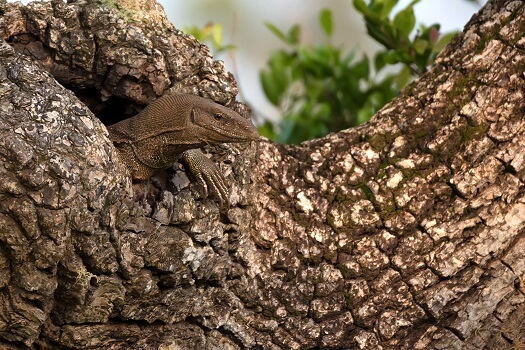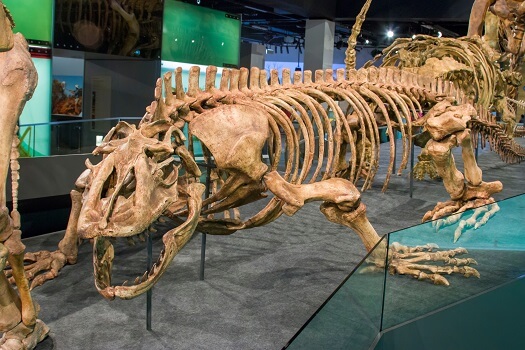
The Monitor Lizard is a large lizard belonging to the family Varanidae. There are 79 species of this reptile and they are native to Africa, Asia, and Oceania. They have also been introduced to the Americas, where they are now considered an invasive species. It is thought that this family of lizards originated in Asia some 65 million years ago! The Monitor Lizard is covered in scales that can range from green to tan, grey, or brown in color. They have large bodies, with long necks and powerful tails. Their limbs are well-developed and they have strong claws. Monitor lizards have long tongues that are forked, like that of snakes. Of the species that still exist today, the Komodo dragon is the largest and can reach over 10 feet (3 meters) in length. The smallest species measure just 7.9 inches (20cm). Most monitor species are terrestrial and found on land but some species will live in trees or are semi-aquatic. Monitor lizards are very territorial and aggressive, lashing out with their tails when provoked. They will also inflate their throats and hiss loudly. Some Monitor Lizards are active hunters, while others prefer to wait and ambush their prey. They are usually carnivorous, eating a wide range of prey including birds, fish, insects, small mammals, and eggs. Some species also eat fruits and other vegetation. These lizards are mostly solitary but have been found to congregate in groups as large as 25 in areas where water is scarce. They don’t have many natural predators but are hunted by humans for their skin and their meat. They are also caught to be sold in the pet trade. Habitat destruction is the main threat to these reptiles and some populations are more at risk than others, depending on their proximity to human settlements. The Komodo Dragon (Varanus komodoensis) is the largest extant lizard in the world and is found on Komodo Island in Indonesia, as well as a few neighboring islands. These lizards have a venomous bite that slowly kills its prey by delivering toxins that prevent blood clotting. Komodo Dragons are not active hunters, they instead prefer to wait to ambush their unsuspecting prey such as pigs, deer, and cattle. The Asian Water Monitor (Varanus salvator), also known as the water monitor, is found in Southeast Asia and can grow up to 9 feet (2.7 m ) in length. They eat a wide range of animals that they actively hunt by swimming, climbing, or chasing after them. They also eat carrion and have even been known to excavate and devour human corpses! The Crocodile Monitor (Varanus salvadorii) is an aggressive species that is hunted for its meat and skin. These large lizards are found in the coastal and mountainous regions on the island of New Guinea. The Nile Monitor (Varanus niloticus) is found throughout Sub-Saharan Africa and along the river Nile. Since the 1990s, breeding populations have also been found in Florida, US. Genetic studies have shown that these animals were introduced and previously belonged to a subpopulation that was found in West Africa. The Bengal Monitor (Varanus bengalensis), also known as the Common Indian Monitor, is found all over the Indian subcontinent as well as other parts of Asia. They are adaptable to a wide range of habitats and as such, they are the most widely distributed of all monitor lizard species. These lizards are often found in agricultural areas. The monitor lizard is a large, powerful lizard that can be found in tropical regions across the world. This family includes the Komodo Dragon, which is the largest species of lizard in existence today. While cross-over with humans has caused populations to decline, these lizards have some wonderful biological adaptations that have enabled them to exist on Earth for a long time. Let’s take a closer look! Komodo Dragons can reproduce asexually using a mechanism known as parthenogenesis. In animals, parthenogenesis is when an embryo develops from an unfertilized egg cell and does not require fertilization by sperm. So how does this happen? Well, both the male and females carry out meiosis, or the dividing of cells to produce sex cells – females produce eggs and the males produce sperm. The sex cells contain half the genetic information of the parents which will provide half the genetic information of the offspring as it will join with the sex cell of the other parent which will provide the other half. In females, meiosis produces four progenitor cells – one of which will eventually become the egg, and three others that are usually reabsorbed by the female’s body. In the case of parthenogenesis in Komodo Dragons, one of these extra progenitor cells replaces the sperm and fertilizes the egg cell. The offspring produced contains the same genetic information as the mother but it is not a clone as genetic shuffling occurs during the production of the eggs. Megalania prisca, more recently renamed as Varanus priscus, was a giant monitor lizard that was found in the open forests, woodlands, and grasslands of Australia. This enormous monitor lizard was up to 16 feet (5 meters) long, making it much bigger than its relative, the Komodo Dragon. This giant lizard was alive during the Pleistocene era or the last ice age. Fossils have been found all over southern Australia, and the youngest fossil found dates back 50,000 years. This coincides with the arrival of Australia’s Aboriginal inhabitants and suggests that humans could have been the cause of these animals going extinct. Monitor lizards are known for being extremely intelligent and have even been taught to count to six in captivity. One example of their intelligence comes from the Nile Monitor Lizard and how it incubates its eggs. When the female is ready to lay her eggs, the Nile Monitor uses its incredibly sharp claws to dig into a termite mound where they then lay their eggs. Termites are hard-working and once they see this hole, they work to close it, and by doing so provide a secure temperature-controlled nest for the lizard’s eggs. Once the eggs hatch the young reptiles can feast on the termites before making their way out of the mound. Nile monitors also work together to steal eggs from Nile crocodiles. While one of these lizards will distract the female crocodile, the others will raid the nest for eggs.
Kingdom
Animalia
Phylum
Chordata
Class
Reptilia
Order
Squamata
Family
Varanidae
Genus
Varanus
Species
Various
Niche
Mostly Carnivorous
Length
Variable, but can reach more than 10 ft (3 m)
Weight
2.2 – 200 lbs (1 to 91 kg)
Lifespan
8 – 30 years
Social Structure
Solitary
Conservation Status
Least Concern
Preferred Habitat
Varies
Average Clutch Size
7 – 37 eggs
Diet
Large and small mammals, birds, snakes, toads, lizards, and eggs
Main Threats
Hunted by humans for food, traditional medicine, and pet trade
The Basics

Notable Monitor Lizard Species

Fun Facts about the Monitor Lizard!
Parthenogenesis in Komodo Dragons
Megalania prisca

Nile Monitor Breeding Methods
